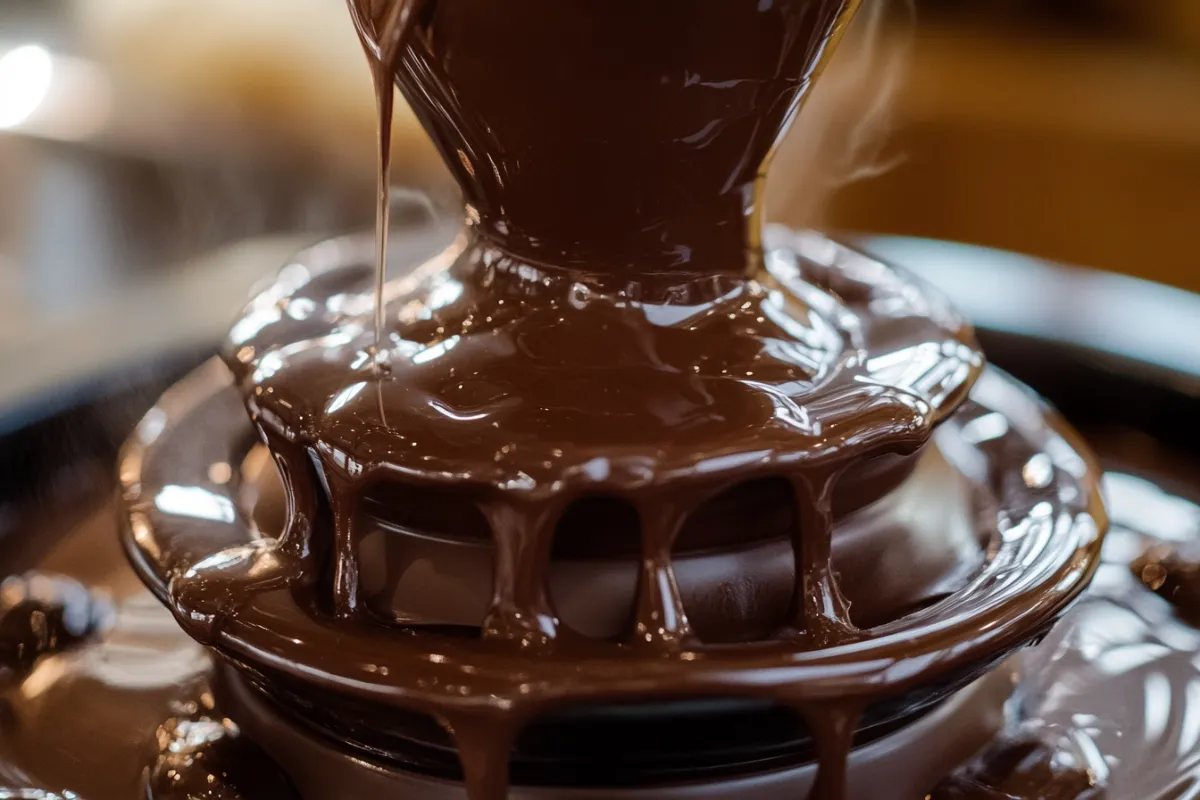How to Do the Chocolate Fountain: A Complete Guide
A chocolate fountain is more than just a dessert—it’s an experience. Whether you’re hosting a wedding, a birthday party, or a corporate event, a chocolate fountain can elevate the entire atmosphere by serving as an indulgent, interactive centerpiece. But, ensuring a smooth chocolate flow and offering the best dipping items requires some preparation and knowledge. So, how exactly do you get a chocolate fountain to work, and what kind of chocolate is best?
In this comprehensive guide, we’ll walk you through every detail of setting up and managing a chocolate fountain, from choosing the right chocolate to cleaning up after the event. By the end, you’ll be well-prepared to create a flawless and delightful chocolate fountain experience for your guests.
1. How Does a Chocolate Fountain Work?
Before setting up your fountain, it’s important to understand how it functions. A chocolate fountain consists of a heated basin at the base that keeps the chocolate melted. Once the chocolate is melted, it is carried upward by an auger or pump through the center of the fountain. When the chocolate reaches the top, it cascades down over the tiers, creating that signature flowing effect.
Key Components of a Chocolate Fountain
- Basin: Where the melted chocolate sits. The basin keeps the chocolate warm and at the right consistency.
- Auger or Pump: This pulls the melted chocolate to the top of the fountain.
- Tiers: As the chocolate flows down the tiers, guests can dip various treats into the warm chocolate stream.
The smooth operation of the fountain depends largely on the chocolate consistency. If the chocolate is too thick or cold, it won’t flow properly, which is why choosing the right type of chocolate and maintaining the correct temperature is essential.
For more on different chocolate varieties, read our Ultimate Guide to Chocolate Bars.
2. Choosing the Right Chocolate for a Fountain
Not all chocolate is suitable for a fountain. The key to success lies in the cocoa butter content of the chocolate. Chocolate with a high percentage of cocoa butter flows more smoothly and evenly. The most recommended type is couverture chocolate, which is specifically designed for melting and flowing.
Why Couverture Chocolate?
- Higher Cocoa Butter Content: This makes couverture chocolate more fluid when melted, ensuring a smooth flow without the need for additional thinning agents.
- Premium Quality: Its texture and flavor are superior, making it the best choice for high-end events and special occasions.
However, if you don’t have couverture chocolate, you can still use other types of chocolate, such as milk, dark, or white chocolate, but you may need to thin them with vegetable oil to achieve the right consistency.
Other Chocolate Options
- Milk Chocolate: Sweet and creamy, milk chocolate is a popular choice, especially for events with children.
- Dark Chocolate: With its slightly bitter and rich flavor, dark chocolate pairs well with fruits and offers a more sophisticated option.
- White Chocolate: This is the sweetest option and can be used for variety, but it is thicker and often requires more thinning than milk or dark chocolate.
For a complete list of top-quality chocolates and brands, visit our article on the Best Chocolate in the World.
3. Preparing Chocolate for the Fountain
The process of preparing the chocolate is crucial to ensure that it flows smoothly in the fountain. Here’s how to melt, thin, and maintain your chocolate to get the best results.
Step 1: Melting the Chocolate
The first step is melting the chocolate. You can use either the double boiler method or the microwave method.
- Double Boiler Method: This is the safest way to melt chocolate without burning it. Place the chocolate in a heatproof bowl over simmering water, stirring it occasionally until smooth.
- Microwave Method: If you’re in a hurry, you can melt the chocolate in the microwave. Use short bursts (about 30 seconds) at medium heat, stirring in between to avoid overheating.
Step 2: Thinning the Chocolate
If you’re using regular milk, dark, or white chocolate, you’ll need to thin it with a fat like vegetable oil or cocoa butter. This is especially important for white chocolate, which is thicker than other types. Start with about ½ cup of oil for every 5 pounds of chocolate and add more if needed to achieve a smooth consistency.
Step 3: Maintaining the Temperature
Chocolate needs to be kept at the right temperature to ensure it stays fluid. Most fountains have a built-in heater, but it’s important to monitor this. The ideal temperature is between 105°F and 115°F.
- Too hot: The chocolate can burn, leading to a grainy texture.
- Too cold: The chocolate will thicken, and the flow will be interrupted.
For a more detailed look at how to prepare chocolate, read our Ultimate Guide to Chocolate.
4. Step-by-Step Guide to Setting Up Your Chocolate Fountain
Once your chocolate is ready, it’s time to set up the fountain. Follow these steps for a flawless setup:
Step 1: Assembling the Fountain
Start by carefully assembling the fountain according to the manufacturer’s instructions. Make sure the base is stable, the auger is securely in place, and the tiers are correctly positioned.
Step 2: Pour the Chocolate
Once the chocolate is melted and thinned, pour it into the basin of the fountain. Turn on the fountain and watch as the auger pulls the chocolate to the top, allowing it to cascade down over the tiers. If the chocolate doesn’t flow smoothly, check the temperature or add more oil.
Step 3: Monitor the Chocolate
Throughout the event, it’s important to check on the fountain regularly. If the chocolate starts to thicken, you can add a little more oil or gently reheat it to restore the proper consistency.
5. Troubleshooting Common Chocolate Fountain Issues
Even with proper preparation, things can go wrong with a chocolate fountain. Here are some common issues and how to fix them:
Issue 1: Chocolate Isn’t Flowing Properly
If your chocolate isn’t flowing evenly, the most likely causes are temperature or consistency issues.
- Solution: Check the temperature and make sure it’s between 105°F and 115°F. If the chocolate is too thick, stir in a small amount of oil or cocoa butter.
Issue 2: Clumping or Grainy Chocolate
If the chocolate has become clumpy or grainy, it’s likely been overheated.
- Solution: Turn off the fountain and allow the chocolate to cool slightly. Stir it gently and reheat it using the double boiler method.
Issue 3: Uneven Flow
An uneven flow is often caused by the fountain being placed on an uneven surface.
- Solution: Make sure the fountain is level. Adjust the base if necessary to ensure smooth flow from all sides.
6. Creative Dipping Ideas for Your Chocolate Fountain
One of the highlights of having a chocolate fountain is choosing the best dipping items. Here are some classic and creative options to offer your guests.
Classic Dipping Items
- Strawberries
- Bananas
- Marshmallows
- Pineapple chunks
- Pretzels
Creative Dipping Items
- Cake Pops: Bite-sized cake pops are fun and perfect for dipping.
- Dried Fruits: Dried apricots, figs, and dates offer a unique flavor contrast with chocolate.
- Bacon: For a surprising twist, bacon adds a savory element to the sweet chocolate.
- Cookies and Biscuits: Shortbread, Oreos, and wafers pair well with both milk and dark chocolate.
For more ideas on dipping items, visit our guide on Creative Dipping Items for Chocolate Fountains.
7. Cleaning and Maintaining Your Chocolate Fountain
After the event is over, cleaning your fountain properly is essential to maintain its longevity. Here’s how to clean and store your fountain.
Step 1: Cleaning the Fountain
Once the chocolate has cooled slightly, but is still in liquid form, turn off the fountain and carefully disassemble the parts. Scrape off any remaining chocolate from the basin and tiers.
- Cleaning Method: Use warm, soapy water to clean each part thoroughly. Some fountains have dishwasher-safe components, but be sure to check the manual.
Step 2: Dry and Store the Fountain
Once cleaned, make sure all parts are completely dry before reassembling or storing. This will prevent rust or damage.
For more detailed maintenance tips, visit our article on the Ultimate Guide to Chocolate Fountains.
8. Fun Facts About Chocolate Fountains
- The world’s largest chocolate fountain is located at the Bellagio Hotel in Las Vegas. It stands over 27 feet tall and circulates 2 tons of chocolate!
- Chocolate fountains were first patented in the 1990s but became mainstream only in the early 2000s when they began appearing at weddings and major events.
- Some innovative caterers even experiment with savory fountains, using melted cheese or other dips instead of chocolate.
9. Frequently Asked Questions (FAQs)
1. What kind of chocolate should I use in a chocolate fountain?
The best chocolate to use is couverture chocolate, thanks to its high cocoa butter content, which ensures smooth flow. Regular chocolate can be used but requires thinning with oil.
2. How much chocolate is needed for a chocolate fountain?
For a small one, 2-4 pounds of chocolate is sufficient. Larger fountains require 5-10 pounds, depending on the number of guests and the size of the fountain.
3. Do I need to add oil to chocolate for a fountain?
Yes, if you’re using regular chocolate (not couverture), you’ll need to add oil—typically about ½ cup for every 5 pounds of chocolate—to ensure the chocolate flows properly.
4. Can I reuse chocolate from a fountain?
Reusing chocolate is not recommended due to hygiene concerns and changes in texture. After being exposed to air and dipping items, the chocolate may no longer flow as smoothly.
5. Can I use chocolate chips in a chocolate fountain?
Yes, but chocolate chips will require thinning with oil or cocoa butter to achieve the proper consistency for flowing in the fountain.
Conclusion: The Perfect Chocolate Fountain Experience
A chocolate fountain adds an unforgettable element to any event, from weddings to birthday parties. By choosing the right type of chocolate, preparing it correctly, and troubleshooting common issues, you can ensure that your fountain flows perfectly and provides an interactive, delicious treat for your guests.
For more details on choosing the right chocolate, preparing it for fountains, and troubleshooting, visit our related articles on Best Chocolate in the World and the Ultimate Guide to Chocolate.

